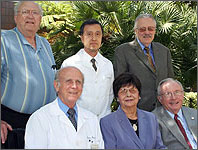M.D.s and D.O.s Today


Interviews
M.D.s and D.O.s in California todayThe 41st Medical TrustIn the years prior to the merger, when the osteopathic profession in California had become increasingly successful, their professional organization had accumulated considerable funds. In 1962, these assets were deposited as a trust which existed separate from the 41st Medical Society. In 1964, the 41st Medical Trust was established, with the purpose to apply the trust corpus and income to further the unification of M.D.s and D.O.s and to support and expand the California College of Medicine. The Trust was to exist for 20 years. After 20 years, on December 31, 1983, the 41st Medical Trust funds were transferred to the UC Irvine College of Medicine support foundation. Since then, the purpose of the Medical Trust has been to conduct research on musculoskeletal manipulation. Victor Passy, M.D., who was well-known and respected among former D.O.s and M.D.s, was appointed to lead a committee of the 41st Medical Trust to provide research funds for qualified studies on musculoskeletal manipulation. Presently the 41st Medical Trust committee includes Dr. Passy, Mrs. Grunigen, and Dr. van den Noort (as depicted in the photo above, seated from left to right), Dr. Kammerman, Dr. Yu, and Dr. Steedman (as depicted standing from left to right). Forest Grunigen, M.D. felt convinced that the integration of musculoskeletal treatments in allopathic medicine would improve healthcare. His hope was that UCI’s strong infrastructure for conducting scientific research would provide opportunities to demonstrate scientifically the effectiveness of musculoskeletal manipulation. Based on such evidence, musculoskeletal manipulation would be practiced by allopathy as well as osteopathy. Throughout his long life he continued to search the world over for researchers who were most respected for their work in basic science and investigations into the efficacy of osteopathic manipulation. The merger in California in 1962 can in part be understood as an effort to close the gulf between allopathy and osteopathy. Was that effort successful?The first impact of the merger was the AMA’s acceptance of COP&S graduates who had taken the M.D. degree in 1962 into its Association. The following year, these new M.D.s were commissioned as medical officers in the military. In 1966, the AMA removed the “cult” label from osteopathy. In 1966, D.O.s already serving in the military were promoted to the rank of medical officer in the Armed Forces and conscripted as medical officers in the military in 1967. The AMA began accepting D.O. graduates in 1969. These series of events occurred as a direct result of the merger. They helped to close the gap between the two professions and made reasonable and respectful communication possible. Finally, in 1974, the California Supreme Court restored the power of the state’s osteopathic licensing board to license new D.O.s in California. Even though the merger did not lead to a merger by other state medical associations or to the conversion of other osteopathic to allopathic medical schools, the effects of the California merger spread nationwide, and gradually even worldwide, in other ways. For example, its effects can be found in the innovative multidisciplinary collaboration in education, research, and treatment approaches. Dr. Haldeman, Clinical Professor of Neurology at UC Irvine, explains that the role of manipulation as a valuable diagnostic and treatment modality no longer is perceived as a threat to allopathy, since scientific methods progressed and produced substantial medical evidence. Valuable interactions occur through the American Back Society, founded by Aubrey Schwartz, M.D., who began medical school at COP&S in 1961, but graduated with an M.D. degree from the California College of Medicine. His vision was to build an inter-professional medical society. Former D.O.s can continue their osteopathic training at the American Back Society by joining an open forum where D.O.s and M.D.s are teaching each other. The American Back Society is an exemplar organization where practitioners of the allopathic and osteopathic healing arts are training together. Increasingly, continuing medical education programs in osteopathic manipulation are attended by M.D.s. Jerome Tobis, M.D. coordinated and co-chaired international interdisciplinary research symposia on spinal manipulation at UC Irvine in 1975 and published the proceedings with Dr. Buerger as “Approaches to the Validation of Manipulation Therapy” (Springfield IL, Charles C. Thomas Publisher, 1977). Contributors included M.D. and D.O.scholars from Canada, England, Sweden, and New Zealand. A decade later, Dr. Tobis and Dr. Hoehler reported on the first randomized clinical trial about the efficacy of spinal manipulation in patients with low back pain and published their findings in JAMA in 1981 and later in “Musculoskeletal Manipulation: Evaluation of the Scientific Evidence” (Springfield IL, Charles C. Thomas Publisher, 1986). It can be argued that these advances would have happened gradually with time, as discrimination became no longer acceptable. Perhaps so, but the effects of social awareness probably would have taken much longer to result in respect and collaboration than the dramatic impact of the California merger’s original goal to improve healthcare through collaboration and research. |